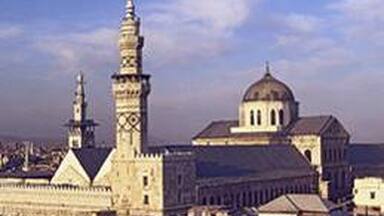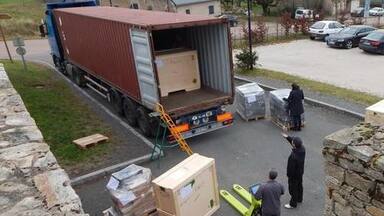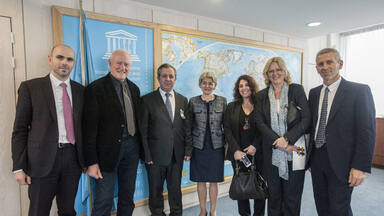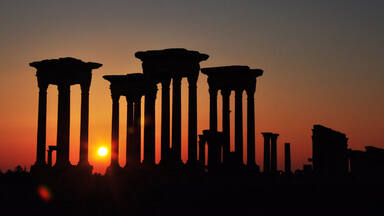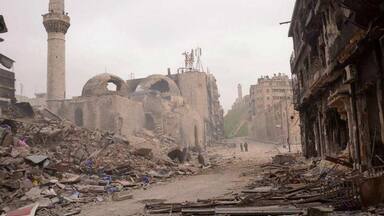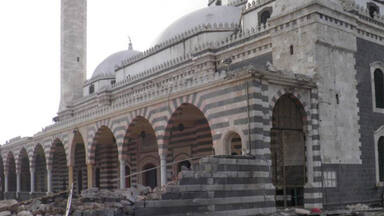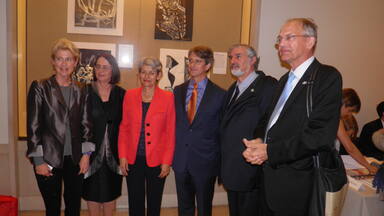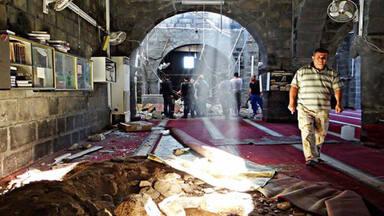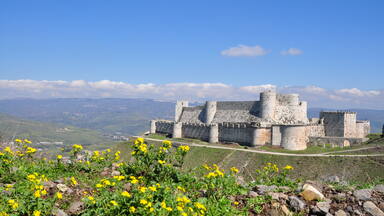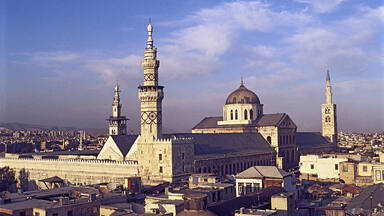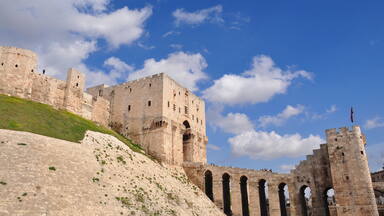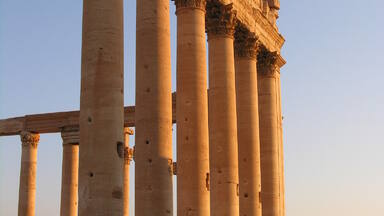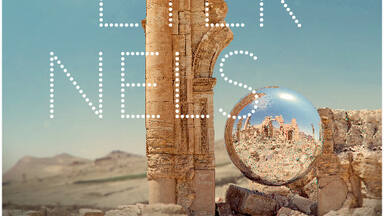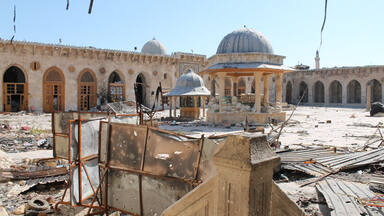Ancient City of Damascus
Ancient City of Damascus
Founded in the 3rd millennium B.C., Damascus is one of the oldest cities in the Middle East. In the Middle Ages, it was the centre of a flourishing craft industry, specializing in swords and lace. The city has some 125 monuments from different periods of its history – one of the most spectacular is the 8th-century Great Mosque of the Umayyads, built on the site of an Assyrian sanctuary.
Description is available under license CC-BY-SA IGO 3.0
Ancienne ville de Damas
Fondée au IIIe millénaire av. J.-C., c'est l'une des plus anciennes villes du Moyen-Orient. Au Moyen Âge, Damas était le centre d'une industrie artisanale florissante (sabres et dentelles). Parmi les 125 monuments des différentes périodes de son histoire, la Grande Mosquée des Omeyyades du VIIIe siècle, édifiée sur le site d'un sanctuaire assyrien, est l'un des plus spectaculaires.
Description is available under license CC-BY-SA IGO 3.0
مدينة دمشق القديمة
تم تأسيس هذه المدينة في الألفية الثالثة قبل الميلاد، ما يجعل منها إحدى أقدم المدن في الشرق الأوسط. وكانت دمشق في القرون الوسطى مركزاً لصناعة حرفية مزدهرة (سيوف وقماش الدنتلاّ)، أما الجامع الأموي الكبير الذي شيد في القرن الثامن في موقع محراب أشوري فيعتبر الأروع بين 125 نصباً ترقى الى مراحل تاريخية مختلفة.
source: UNESCO/CPE
Description is available under license CC-BY-SA IGO 3.0
大马士革古城
大马士革古城建于公元前3000年,是中东地区最古老的城市之一。中世纪时期,大马士革是繁荣的手工业中心,专门于刀剑和饰带的制作。在它源于不同历史时期的125个纪念性建筑物中,以公元8世纪即倭马亚王朝哈里发时期的大清真寺最为壮观,大清真寺建在亚述国的一块圣地上。
source: UNESCO/CPE
Description is available under license CC-BY-SA IGO 3.0
Старый город в Дамаске
Основанный в 3-м тысячелетии до н.э., Дамаск является одним из старейших городов на Ближнем Востоке. В средневековье это был центр процветающих ремесел, прославившийся своими клинками и кружевами. В городе находится около 125 памятников, относящихся к разным периодам его истории. Один из самых значительных – Большая мечеть Омейядов, построенная в VIII в. на месте ассирийского святилища.
source: UNESCO/CPE
Description is available under license CC-BY-SA IGO 3.0
Ciudad vieja de Damasco
Fundada en el tercer milenio a.C., Damasco es una de las ciudades más antiguas del Oriente Medio. En la Edad Media fue el centro de una próspera industria artesanal especializada en la fabricación de espadas y encajes. De los 125 monumentos que conserva de los distintos períodos de su historia, uno de los más espectaculares es la gran mezquita de los omeyas, construida el siglo VIII en el emplazamiento de un santuario asirio.
source: UNESCO/CPE
Description is available under license CC-BY-SA IGO 3.0
古都ダマスクス
source: NFUAJ
Oude stad van Damascus
Source: unesco.nl
Outstanding Universal Value
Brief synthesis
Founded in the 3rd millennium B.C., Damascus was an important cultural and commercial centre, by virtue of its geographical position at the crossroads of the orient and the occident, between Africa and Asia. The old city of Damascus is considered to be among the oldest continually inhabited cities in the world. Excavations at Tell Ramad on the outskirts of the city have demonstrated that Damascus was inhabited as early as 8,000 to 10,000 BC. However, it is not documented as an important city until the arrival of the Aramaeans. In the Medieval period, it was the centre of a flourishing craft industry, with different areas of the city specializing in particular trades or crafts.
The city exhibits outstanding evidence of the civilizations which created it - Hellenistic, Roman, Byzantine and Islamic. In particular, the Umayyad caliphate created Damascus as its capital, setting the scene for the city's ongoing development as a living Muslim, Arab city, upon which each succeeding dynasty has left and continues to leave its mark.
In spite of Islam's prevailing influence, traces of earlier cultures particularly the Roman and Byzantine continue to be seen in the city. Thus the city today is based on a Roman plan and maintains the aspect and the orientation of the Greek city, in that all its streets are oriented north-south or east-west and is a key example of urban planning.
The earliest visible physical evidence dates to the Roman period - the extensive remains of the Temple of Jupiter, the remains of various gates and an impressive section of the Roman city walls. The city was the capital of the Umayyad Caliphate. However, apart from the incomparable Great Mosque, built on the site of a Roman temple and over-laying a Christian basilica, there is little visible dating from this important era of the city's history. The present city walls, the Citadel, some mosques and tombs survive from the Middle Ages, but the greatest part of the built heritage of the city dates from after the Ottoman conquest of the early 16th century.
Criterion (i): Damascus testifies to the unique aesthetic achievement of the civilizations which created it. The Great Mosque is a masterpiece of Umayyad architecture, which together with other major monuments of different periods such as the Citadel, the Azem Palace, madrasas, khans, public baths and private residences demonstrates this achievement.
Criterion (ii): Damascus, as capital of the Umayyad caliphate - the first Islamic caliphate - was of key importance in the development of subsequent Arab cities. With its Great Mosque at the heart of an urban plan deriving from the Graeco-Roman grid, the city provided the exemplary model for the Arab Muslim world.
Criterion (iii): Historical and archaeological sources testify to origins in the third millennium BC, and Damascus is widely known as among the oldest continually inhabited cities in the world. The incomparable Great Mosque is a rare and extremely significant monument of the Umayyads. The present city walls, the Citadel, some mosques and tombs survive from the Medieval period, and a large part of the built heritage of the city including palaces and private houses dates from after the Ottoman conquest of the early 16th century.
Criterion (iv): The Umayyad Great Mosque, also known as the Grand Mosque of Damascus, is one of the largest mosques in the world, and one of the oldest sites of continuous prayer since the rise of Islam. As such it constitutes an important cultural, social and artistic development.
Criterion (vi): The city is closely linked with important historical events, ideas, traditions, especially from the Islamic period. These have helped to shape the image of the city and impact of Islamic history and culture.
Integrity (2009)
The line of the walls of the old city forms the boundary of the property. Although areas outside the walls that represent the expansion of the city from the 13th century, are considered related to the old city in terms of historical significance, and provide its setting and context, the key attributes of Outstanding Universal Value lie within the boundary. These include the plan of the city and its dense urban fabric, city walls and gates, as well as its 125 protected monuments including the Umayyad Mosque, madrasas, khans, the Citadel and private houses.
The attributes are vulnerable to erosion from a lack of traditional approaches to maintenance and conservation, and use of traditional materials, while its setting and context are threatened by lack of conservation policy for the historical zones outside the walled city and by regional planning projects.
Authenticity (2009)
Since the inscription of the property, the morphological layout and the spatial pattern of the historic fabric have remained basically unchanged and the key discrete attributes survive. However commercial and semi-industrial activities are spreading into the residential area of the walled city and its suburbs, in places eroding the value of the attributes relating to the urban fabric and their inter-relationships.
Protection and management requirements (2009)
Responsibilities for planning control over the old city and its management are in the hands of two government departments (the Commission for Safeguarding the Old Town and the General Directorate for Antiquities and Museums (DGAM). Technical Cooperation for projects and programmes to enhance the city is undertaken by the Ministry of Local Administration and Environment with support from international organizations. The effectiveness of the conservation policy relies on full participation of various interests within the city such as public/private partnerships, all levels of government, the financial community, and citizens.
Legal protection is provided by the Antiquities law 222 amended in 1999 in addition to the Ministerial order no. 192 of 1976 designating the walled city as part of the cultural and historical heritage of Syria. Parliamentary Act N° 826 for the Restoration and Reconstruction/Rebuilding the city within the walls has been reviewed in light of changed conditions, needs and opportunities, and aims at establishing new conditions for the walled city.
A Committee for the Protection and Development of Old Damascus has been established, with representatives of the different bodies to coordinate the planning and building activities in addition to being responsible for the strategic planning for the Old City.
The draft of the Integrated Urban Plan of the old city had been formally approved by Ministerial decision N° 37/A of 2010. A buffer zone has also been delineated but not yet formally approved.
There is a need for the plan, once approved and implemented, to clarify the different levels of protection to be applied to the different parts of the urban fabric, to set out the appropriate interventions
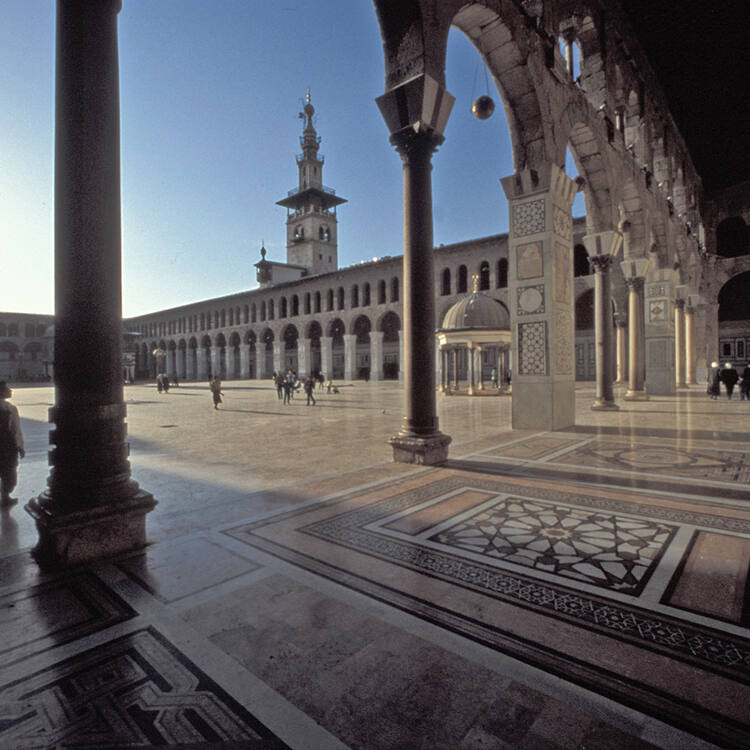
 View photos from OUR PLACE the World Heritage collection
View photos from OUR PLACE the World Heritage collection

